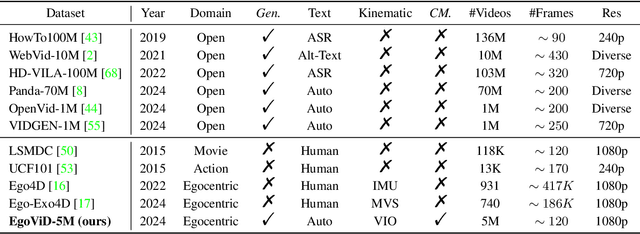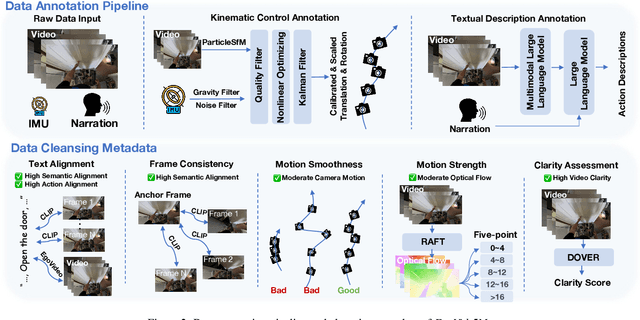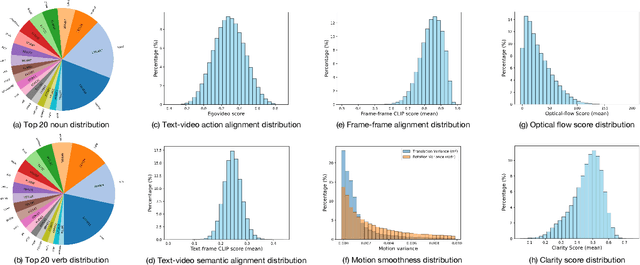Zheng Zhu
Tencent, WeChat Pay
Dynamic Vision Mamba
Apr 07, 2025Abstract:Mamba-based vision models have gained extensive attention as a result of being computationally more efficient than attention-based models. However, spatial redundancy still exists in these models, represented by token and block redundancy. For token redundancy, we analytically find that early token pruning methods will result in inconsistency between training and inference or introduce extra computation for inference. Therefore, we customize token pruning to fit the Mamba structure by rearranging the pruned sequence before feeding it into the next Mamba block. For block redundancy, we allow each image to select SSM blocks dynamically based on an empirical observation that the inference speed of Mamba-based vision models is largely affected by the number of SSM blocks. Our proposed method, Dynamic Vision Mamba (DyVM), effectively reduces FLOPs with minor performance drops. We achieve a reduction of 35.2\% FLOPs with only a loss of accuracy of 1.7\% on Vim-S. It also generalizes well across different Mamba vision model architectures and different vision tasks. Our code will be made public.
HumanDreamer-X: Photorealistic Single-image Human Avatars Reconstruction via Gaussian Restoration
Apr 04, 2025Abstract:Single-image human reconstruction is vital for digital human modeling applications but remains an extremely challenging task. Current approaches rely on generative models to synthesize multi-view images for subsequent 3D reconstruction and animation. However, directly generating multiple views from a single human image suffers from geometric inconsistencies, resulting in issues like fragmented or blurred limbs in the reconstructed models. To tackle these limitations, we introduce \textbf{HumanDreamer-X}, a novel framework that integrates multi-view human generation and reconstruction into a unified pipeline, which significantly enhances the geometric consistency and visual fidelity of the reconstructed 3D models. In this framework, 3D Gaussian Splatting serves as an explicit 3D representation to provide initial geometry and appearance priority. Building upon this foundation, \textbf{HumanFixer} is trained to restore 3DGS renderings, which guarantee photorealistic results. Furthermore, we delve into the inherent challenges associated with attention mechanisms in multi-view human generation, and propose an attention modulation strategy that effectively enhances geometric details identity consistency across multi-view. Experimental results demonstrate that our approach markedly improves generation and reconstruction PSNR quality metrics by 16.45% and 12.65%, respectively, achieving a PSNR of up to 25.62 dB, while also showing generalization capabilities on in-the-wild data and applicability to various human reconstruction backbone models.
WonderTurbo: Generating Interactive 3D World in 0.72 Seconds
Apr 03, 2025Abstract:Interactive 3D generation is gaining momentum and capturing extensive attention for its potential to create immersive virtual experiences. However, a critical challenge in current 3D generation technologies lies in achieving real-time interactivity. To address this issue, we introduce WonderTurbo, the first real-time interactive 3D scene generation framework capable of generating novel perspectives of 3D scenes within 0.72 seconds. Specifically, WonderTurbo accelerates both geometric and appearance modeling in 3D scene generation. In terms of geometry, we propose StepSplat, an innovative method that constructs efficient 3D geometric representations through dynamic updates, each taking only 0.26 seconds. Additionally, we design QuickDepth, a lightweight depth completion module that provides consistent depth input for StepSplat, further enhancing geometric accuracy. For appearance modeling, we develop FastPaint, a 2-steps diffusion model tailored for instant inpainting, which focuses on maintaining spatial appearance consistency. Experimental results demonstrate that WonderTurbo achieves a remarkable 15X speedup compared to baseline methods, while preserving excellent spatial consistency and delivering high-quality output.
HumanDreamer: Generating Controllable Human-Motion Videos via Decoupled Generation
Apr 01, 2025Abstract:Human-motion video generation has been a challenging task, primarily due to the difficulty inherent in learning human body movements. While some approaches have attempted to drive human-centric video generation explicitly through pose control, these methods typically rely on poses derived from existing videos, thereby lacking flexibility. To address this, we propose HumanDreamer, a decoupled human video generation framework that first generates diverse poses from text prompts and then leverages these poses to generate human-motion videos. Specifically, we propose MotionVid, the largest dataset for human-motion pose generation. Based on the dataset, we present MotionDiT, which is trained to generate structured human-motion poses from text prompts. Besides, a novel LAMA loss is introduced, which together contribute to a significant improvement in FID by 62.4%, along with respective enhancements in R-precision for top1, top2, and top3 by 41.8%, 26.3%, and 18.3%, thereby advancing both the Text-to-Pose control accuracy and FID metrics. Our experiments across various Pose-to-Video baselines demonstrate that the poses generated by our method can produce diverse and high-quality human-motion videos. Furthermore, our model can facilitate other downstream tasks, such as pose sequence prediction and 2D-3D motion lifting.
Exploring Large Language Models in Healthcare: Insights into Corpora Sources, Customization Strategies, and Evaluation Metrics
Feb 17, 2025Abstract:This study reviewed the use of Large Language Models (LLMs) in healthcare, focusing on their training corpora, customization techniques, and evaluation metrics. A systematic search of studies from 2021 to 2024 identified 61 articles. Four types of corpora were used: clinical resources, literature, open-source datasets, and web-crawled data. Common construction techniques included pre-training, prompt engineering, and retrieval-augmented generation, with 44 studies combining multiple methods. Evaluation metrics were categorized into process, usability, and outcome metrics, with outcome metrics divided into model-based and expert-assessed outcomes. The study identified critical gaps in corpus fairness, which contributed to biases from geographic, cultural, and socio-economic factors. The reliance on unverified or unstructured data highlighted the need for better integration of evidence-based clinical guidelines. Future research should focus on developing a tiered corpus architecture with vetted sources and dynamic weighting, while ensuring model transparency. Additionally, the lack of standardized evaluation frameworks for domain-specific models called for comprehensive validation of LLMs in real-world healthcare settings.
ReconDreamer: Crafting World Models for Driving Scene Reconstruction via Online Restoration
Nov 29, 2024



Abstract:Closed-loop simulation is crucial for end-to-end autonomous driving. Existing sensor simulation methods (e.g., NeRF and 3DGS) reconstruct driving scenes based on conditions that closely mirror training data distributions. However, these methods struggle with rendering novel trajectories, such as lane changes. Recent works have demonstrated that integrating world model knowledge alleviates these issues. Despite their efficiency, these approaches still encounter difficulties in the accurate representation of more complex maneuvers, with multi-lane shifts being a notable example. Therefore, we introduce ReconDreamer, which enhances driving scene reconstruction through incremental integration of world model knowledge. Specifically, DriveRestorer is proposed to mitigate artifacts via online restoration. This is complemented by a progressive data update strategy designed to ensure high-quality rendering for more complex maneuvers. To the best of our knowledge, ReconDreamer is the first method to effectively render in large maneuvers. Experimental results demonstrate that ReconDreamer outperforms Street Gaussians in the NTA-IoU, NTL-IoU, and FID, with relative improvements by 24.87%, 6.72%, and 29.97%. Furthermore, ReconDreamer surpasses DriveDreamer4D with PVG during large maneuver rendering, as verified by a relative improvement of 195.87% in the NTA-IoU metric and a comprehensive user study.
EgoVid-5M: A Large-Scale Video-Action Dataset for Egocentric Video Generation
Nov 13, 2024



Abstract:Video generation has emerged as a promising tool for world simulation, leveraging visual data to replicate real-world environments. Within this context, egocentric video generation, which centers on the human perspective, holds significant potential for enhancing applications in virtual reality, augmented reality, and gaming. However, the generation of egocentric videos presents substantial challenges due to the dynamic nature of egocentric viewpoints, the intricate diversity of actions, and the complex variety of scenes encountered. Existing datasets are inadequate for addressing these challenges effectively. To bridge this gap, we present EgoVid-5M, the first high-quality dataset specifically curated for egocentric video generation. EgoVid-5M encompasses 5 million egocentric video clips and is enriched with detailed action annotations, including fine-grained kinematic control and high-level textual descriptions. To ensure the integrity and usability of the dataset, we implement a sophisticated data cleaning pipeline designed to maintain frame consistency, action coherence, and motion smoothness under egocentric conditions. Furthermore, we introduce EgoDreamer, which is capable of generating egocentric videos driven simultaneously by action descriptions and kinematic control signals. The EgoVid-5M dataset, associated action annotations, and all data cleansing metadata will be released for the advancement of research in egocentric video generation.
A Modulo Sampling Hardware Prototype and Reconstruction Algorithm Evaluation
Oct 25, 2024Abstract:Analog-to-digital converters (ADCs) play a vital important role in any devices via manipulating analog signals in a digital manner. Given that the amplitude of the signal exceeds the dynamic range of the ADCs, clipping occurs and the quality of the digitized signal degrades significantly. In this paper, we design a joint modulo sampling hardware and processing prototype which improves the ADCs' dynamic range by folding the signal before sampling. Both the detailed design of the hardware and the recovery results of various state-of-the-art processing algorithms including our proposed unlimited sampling line spectral estimation (USLSE) algorithm are presented. Additionally, key issues that arise during implementation are also addressed. It is demonstrated that the USLSE algorithm successfully recovers the original signal with a frequency of 2.5 kHz and an amplitude 10 times the ADC's dynamic range, and the linear prediction (LP) algorithm successfully recovers the original signal with a frequency of 3.5 kHz and an amplitude 10 times the ADC's dynamic range.
Ubiquitous Field Transportation Robots with Robust Wheel-Leg Transformable Modules
Oct 24, 2024



Abstract:This paper introduces two field transportation robots. Both robots are equipped with transformable wheel-leg modules, which can smoothly switch between operation modes and can work in various challenging terrains. SWhegPro, with six S-shaped legs, enables transporting loads in challenging uneven outdoor terrains. SWhegPro3, featuring four three-impeller wheels, has surprising stair-climbing performance in indoor scenarios. Different from ordinary gear-driven transformable mechanisms, the modular wheels we designed driven by self-locking electric push rods can switch modes accurately and stably with high loads, significantly improving the load capacity of the robot in leg mode. This study analyzes the robot's wheel-leg module operation when the terrain parameters change. Through the derivation of mathematical models and calculations based on simplified kinematic models, a method for optimizing the robot parameters and wheel-leg structure parameters is finally proposed.The design and control strategy are then verified through simulations and field experiments in various complex terrains, and the working performance of the two field transportation robots is calculated and analyzed by recording sensor data and proposing evaluation methods.
DriveDreamer4D: World Models Are Effective Data Machines for 4D Driving Scene Representation
Oct 17, 2024



Abstract:Closed-loop simulation is essential for advancing end-to-end autonomous driving systems. Contemporary sensor simulation methods, such as NeRF and 3DGS, rely predominantly on conditions closely aligned with training data distributions, which are largely confined to forward-driving scenarios. Consequently, these methods face limitations when rendering complex maneuvers (e.g., lane change, acceleration, deceleration). Recent advancements in autonomous-driving world models have demonstrated the potential to generate diverse driving videos. However, these approaches remain constrained to 2D video generation, inherently lacking the spatiotemporal coherence required to capture intricacies of dynamic driving environments. In this paper, we introduce \textit{DriveDreamer4D}, which enhances 4D driving scene representation leveraging world model priors. Specifically, we utilize the world model as a data machine to synthesize novel trajectory videos based on real-world driving data. Notably, we explicitly leverage structured conditions to control the spatial-temporal consistency of foreground and background elements, thus the generated data adheres closely to traffic constraints. To our knowledge, \textit{DriveDreamer4D} is the first to utilize video generation models for improving 4D reconstruction in driving scenarios. Experimental results reveal that \textit{DriveDreamer4D} significantly enhances generation quality under novel trajectory views, achieving a relative improvement in FID by 24.5\%, 39.0\%, and 10.5\% compared to PVG, $\text{S}^3$Gaussian, and Deformable-GS. Moreover, \textit{DriveDreamer4D} markedly enhances the spatiotemporal coherence of driving agents, which is verified by a comprehensive user study and the relative increases of 20.3\%, 42.0\%, and 13.7\% in the NTA-IoU metric.
 Add to Chrome
Add to Chrome Add to Firefox
Add to Firefox Add to Edge
Add to Edge